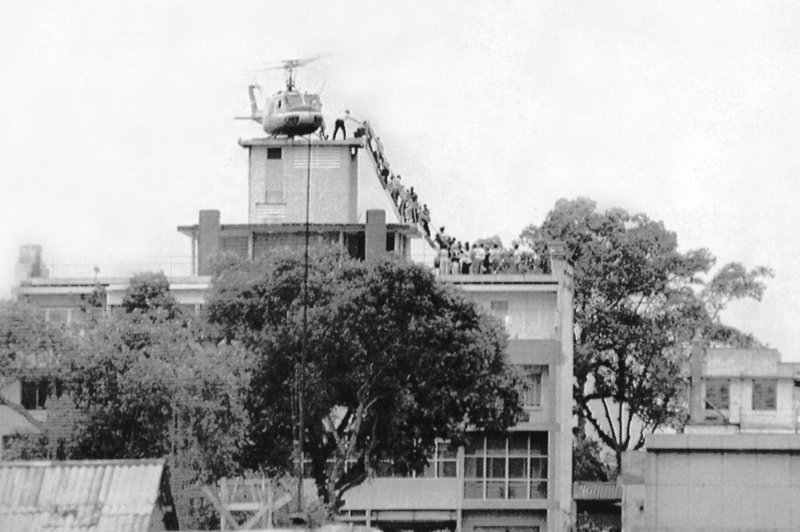1 of 3 | An Air America helicopter crew member helps evacuees up a ladder on the roof of 18 Gia Long St. on April 29, 1975 in Saigon, South Vietnam shortly before the city fell to advancing North Vietnamese troops. File Photo by Hugh Van Es/UPI |
License Photo
HO CHI MINH CITY, Vietnam, April 30 (UPI) -- Vietnam celebrates Reunification Day on Thursday, the day in 1975 that Saigon, the capital of South Vietnam, fell to the People's Army of Vietnam.
It ended the Vietnam War, although only about 1,250 Americans remained in the country by that point. The final approach of the army, which rapidly overtook the South Vietnamese cities of Hue and Da Nang in March, involved the shelling of Saigon on April 29, rendering the runways of its Tan So Nhat airport inoperable. The "Ho Chi Minh" campaign, that final push of the army named by the North Vietnamese Politburo after its revolutionary leader, was at the outskirts of the city.
It was because the airport was ruined by the shelling -- a burning C-130 transport plane blocked a runway -- that the final evacuation of U.S. personnel and South Vietnamese allies and dependents was dependent largely on helicopters and "Operation Frequent Wind," ferrying refugees to ship awaiting their arrival.
The evacuees were bused to agreed-upon points in Saigon, a city largely unscathed by the war, and boarded shuttling helicopters in groups of 20 to 50, although several arrived at aircraft carriers, and in Thailand and elsewhere, aboard private planes. Others filled boats, including those of the South Vietnamese navy, and were met by the U.S. Seventh Fleet in the South China Sea.
The famous photograph of evacuees climbing a staircase to a waiting helicopter, taken by Hugh Van Es of UPI, is of the top of an apartment building that housed U.S. government employees at Saigon's 22 Gia Long St., and not, as commonly believed, of the roof of the U.S. Embassy. The building, now privately owned, still stands.
The South Vietnamese government, supported by the United States, surrendered to Communist North Vietnam. By April 29, U.S. President Gerald Ford ordered the complete evacuation of American forces from South Vietnam, and the presidential palace was in enemy hands; President Nguyen Van Thieu had resigned on April 21, his prime minister, Tran Thien Khiem, several days earlier.
The first two North Vietnamese tanks to burst through the gates of the palace remain there, on display on the lawn. Leon Daniel, a UPI reporter, stayed, and noted, "In the days that followed, we walked the streets freely, observing the curious peace. So we ventured out into the street, grinning at some of the Communist troops we'd only seen beforehand on battlefields. We were relieved when some of them grinned back."
The completed departure removed 4,000 people from Saigon, 950 of them Americans, the U.S. Department of Defense said. Those who remained left eventually, and tended to be critical of the evacuation, although since Saigon was under curfew and the few in the streets were departing, it was regarded as an orderly operation.
"A crowd of Vietnamese, some angry, some frightened, pushed against the gates of the U.S. Embassy as U.S. Marines were landed by helicopters inside the walled compound. Marine reinforcements kept the crowd outside the compound to prevent the mob scenes that marked the flight from Da Nang," recalled UPI reporter Alan Dawson.
The new soldiers in Saigon, quickly renamed Ho Chi Minh City, were polite, reserved and looked relieved, noted Martin Woollacott of the British newspaper the Guardian, and well-trained. When gunfire, in a last-ditch assault on North Vietnamese troops, broke out near the presidential palace, the lounging soldiers immediately formed, returned fire and outflanked the enemy.
"It was a reminder that the time when the war was about under-equipped guerrillas taking on big, conventional forces, was long gone," Woollacott reminisced.
The war remains a divisive issue in history. "Reunification Day," as the Vietnamese government calls it, is "Thang Tu Den," or "Black April" to some expatriates.















